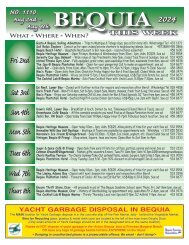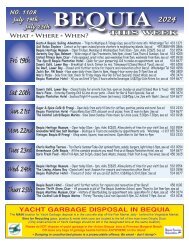Caribbean Compass Yachting Magazine - May/June 2022
Welcome to Caribbean Compass, the most widely-read boating publication in the Caribbean! THE MOST NEWS YOU CAN USE - feature articles on cruising destinations, regattas, environment, events...
Welcome to Caribbean Compass, the most widely-read boating publication in the Caribbean! THE MOST NEWS YOU CAN USE - feature articles on cruising destinations, regattas, environment, events...
You also want an ePaper? Increase the reach of your titles
YUMPU automatically turns print PDFs into web optimized ePapers that Google loves.
— Continued from previous page<br />
Also, once above 19°N or once in the <strong>Caribbean</strong> Sea<br />
they become so erratic that their tracks are difficult to<br />
predict accurately.<br />
November, remember!<br />
Hurricane season still peaks around<br />
September 10th, and storms remain<br />
most likely to form between early<br />
August and mid-October.<br />
In 1965, NOAA moved the official end<br />
of hurricane season from October 31st<br />
to November 30th, and in the late<br />
1990s insurance companies followed<br />
suit by changing their hurricane<br />
season closing date to November 30th.<br />
Why? In the last 40 years there have<br />
been more November hurricanes than<br />
in the previous hundred years.<br />
Historically the period from <strong>June</strong> 1st to<br />
November 30th encompasses about 97<br />
percent of the tropical activity in the<br />
Atlantic basin.<br />
However, NOAA paints hurricanes<br />
with a broad brush. It tracks hurricanes<br />
in the Gulf of Mexico, the Western<br />
<strong>Caribbean</strong>, the Bahamas, the East<br />
Coast of the US and the whole Atlantic.<br />
But let’s look at hurricanes as they<br />
affect the Eastern <strong>Caribbean</strong>.<br />
The only two November hurricanes to<br />
affect the Lesser Antilles since 1981 were<br />
oddballs — they started in the <strong>Caribbean</strong><br />
and headed east. In early November<br />
1984 Klaus formed south of Puerto Rico,<br />
headed northeast hitting the US and<br />
British Virgin Islands, and continued<br />
eastward passing north of St. Martin.<br />
(See how the engineless yawl Iolaire,<br />
caught unaware on a lee coast, survived<br />
at anchor at www.street-iolaire,<br />
“Surviving Klaus”.)<br />
The fourth strongest November hurricane on record<br />
was 1999’s famous “Wrong Way Lenny.” Lenny formed<br />
on November 13th in the western <strong>Caribbean</strong> and<br />
maintained a west-to-east track for its entire duration.<br />
It attained hurricane status south of Jamaica on<br />
November 15th and passed south of Hispaniola and<br />
Puerto Rico over the next few days. Lenny rapidly<br />
intensified over the northeastern <strong>Caribbean</strong> on November<br />
17th, attaining peak winds of 134 knots about 21 miles<br />
south of St. Croix. It gradually weakened while moving<br />
through the Leeward Islands, eventually dissipating on<br />
November 23rd over the open Atlantic. Lenny’s storm<br />
surges affected the entire Eastern <strong>Caribbean</strong> chain.<br />
In summary<br />
So, if we conclude that all of <strong>June</strong>, the first two<br />
weeks of July, and the whole month of November are<br />
at low risk for hurricanes in the Eastern <strong>Caribbean</strong>,<br />
that gives a chartering and cruising season of a full<br />
eight-and-a-half months, including a glorious early<br />
summer period. Not bad!<br />
Minimize your risk when hauled out for the 15-week<br />
mid-July to late October period — or even keep<br />
cruising with a sharp eye on the weather — and the<br />
Eastern <strong>Caribbean</strong> remains one of the world’s best<br />
sailing grounds.<br />
For more of Don Street’s writings on many aspects of<br />
hurricanes in the <strong>Caribbean</strong>, from experiences to<br />
insurance, visit www.street-iolaire.com.<br />
A <strong>June</strong> sunset in Carriacou. The weather is settled<br />
and the crowds are gone.<br />
MAY/JUNE <strong>2022</strong> CARIBBEAN COMPASS PAGE 23

















